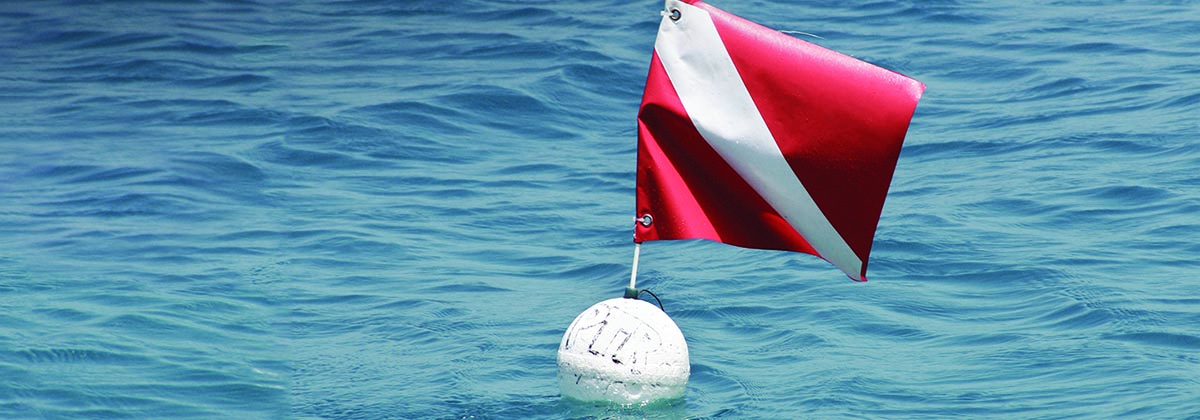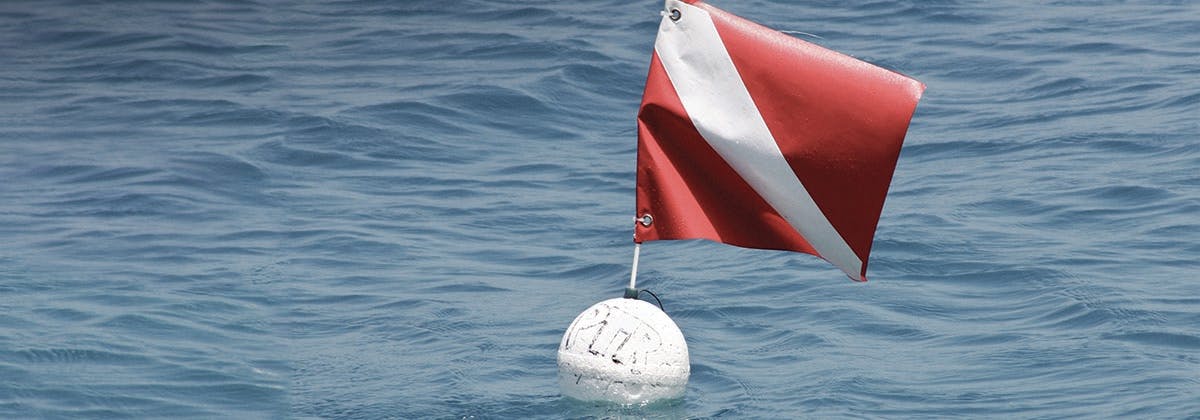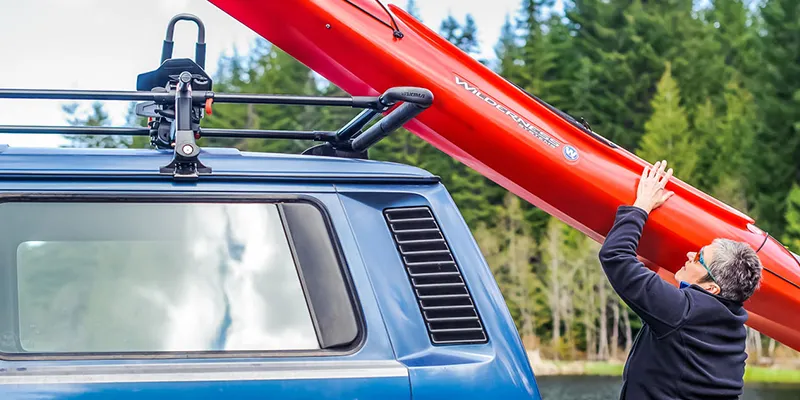
- Alabama
- Alaska
- Arizona
- Arkansas
- California
- Colorado
- Connecticut
- Delaware
- Florida
- Georgia
- Hawaii
- Idaho
- Illinois
- Indiana
- Iowa
- Kansas
- Kentucky
- Louisiana
- Maine
- Maryland
- Massachusetts
- Michigan
- Minnesota
- Mississippi
- Missouri
- Montana
- Nebraska
- Nevada
- New Hampshire
- New Jersey
- New Mexico
- New York
- North Carolina
- North Dakota
- Ohio
- Oklahoma
- Oregon
- Pennsylvania
- Rhode Island
- South Carolina
- South Dakota
- Tennessee
- Texas
- Utah
- Vermont
- Virginia
- Washington
- West Virginia
- Wisconsin
- Wyoming
When You See A Red Flag With A White Diagonal Stripe, Do This
RED FLAG
When boating and you encounter a red flag with a white diagonal stripe, it indicates the presence of scuba divers in the vicinity. It's essential to reduce speed and maintain a safe distance of at least 300 feet. This "diver down" flag, introduced in 1956, is a communication tool in maritime settings to protect divers. Divers might not always be under their flag, so vigilance is necessary. Ensuring safety, avoiding potential hazards, and adhering to maritime signals are paramount for an enjoyable time on the water.
Imagine you're out on the water, reclining in your powerboat while the sun casts a warm glow and the water feels inviting. Then, without warning, a "red flag with a white stripe" appears on your horizon. Are you aware of the correct actions to take in response?
While cruising on the water, spotting a "red flag with white stripe" indicates that you're nearing a group of scuba divers. It's critical to reduce your boat's speed and keep at least a 300-foot distance from the "red flag with white stripe." Being mindful of your surroundings is crucial to preserve the water's condition for everyone. This experience underscores the need to understand and interpret various signals and flags that guide maritime traffic.
Above all, ensuring safety when navigating your boat and preventing potential hazards beneath the water surface are integral aspects of boating safety.
In the following sections, we will dissect the meaning of the "red flag with white stripe" and advise on the appropriate steps to take if you encounter one. We will also share some expert tips for reacting correctly if you share the water with a specific group of watersport enthusiasts.
Have you heard about the sailor who broke up with his girlfriend? She kept suggesting he should "sea" other people! But on observing others, it's imperative to maintain a safe distance from scuba divers when you see a "red flag with white stripe" on the water. This isn't just about compliance; it's about ensuring everyone's safety and enjoyment.
Are you interested in more details? Keep reading to empower yourself with essential knowledge that can help safeguard you and those around you.
Diver Down Flag
What Exactly Does That Red Flag Mean?
RED FLAG
Flags to communicate information between ships date back to ancient maritime civilizations such as the Greeks and the Phoenicians. In the 19th century, the International Code of Signals was developed, which standardized flags for communicating messages such as distress signals, navigation instructions, and weather warnings. Today, the use of flags remains an integral part of maritime communication and safety.
Denzel James Dockery, a veteran of the United States Navy, designed this flag back in 1956. In addition, Ted Nixon of US Divers was the one who popularized it in subsequent years. This essential gear, also known as the diver down flag, is something that every scuba group should bring and display.
To comply with the legislation, divers in the United States of America, Canada, and certain nations in Europe must display it while underwater. However, there is a significant likelihood that the diving group is not immediately beneath their flag.
Scuba divers should maintain a distance of no more than 300 feet (90 meters) from their dive flag or stationary buoy in open water. The recommended length is one hundred feet or thirty meters shorter in waterways such as rivers, inlets, and channels. In addition, scuba diving groups should plan to surface within 45 meters (150 feet) of their dive flag whenever possible.
RED FLAG
The diver-down flag needs to be at least 20 inches by 24 inches and should be flown from the highest position on the vessel, and this will ensure that it is seen from a considerable distance. If the flag is to be displayed from a surface marker buoy, it needs to be mounted in an upright posture, and it needs to be at least 12 inches by 12 inches in size.
Additionally, the blue and white alpha flag is permitted to be flown by divers in some areas of the world. When a vessel's mobility is limited in some way, this internationally recognized symbol is displayed to let other people know about it. It is common practice to fly this flag alongside the diver down flag whenever divers are present in the water, and it signifies that other vessels should give way to the current boat in the water.
Safety Concerns When Boating Near Scuba Divers
It would help if you never put yourself in the position of divers while driving or captaining a boat since it's irresponsible. When in doubt, maintain a distance of at least 300 feet between your vessel and its flag.
Remember that even though displaying the diver down flag is legally mandated, not all dive groups choose to do so. You should constantly be on the watch for persons in the water, even if you do not see a flag or buoy indicating that there are people in the water. After all, the operator's alertness is the most effective technique to forestall the occurrence of mishaps.
Safety Advice Related To Scuba Diving
Remember that surface divers won't always be easy to spot since this is another crucial fact.
It may be difficult to see the waterline in small, open watercraft such as a Jon boat due to the glare from the sun and rough weather conditions such as heavy waves and swell. It's not uncommon to have larger pontoon boats packed to capacity with visitors milling about. This could obstruct your view while driving the ship, which is one of the many reasons why passengers should remain seated whenever the boat is moving.
If you know there are divers underwater nearby, you must establish direct communication with the vessel they are aboard. Even when it is not turning, you should ensure that these scuba divers do not come into contact with the propeller of your submarine. Even a stationary propeller threatens severe injury if it unintentionally touches a person.
Ensure no divers are in the area or underneath your propeller before you start your boat. This can be performed by conversing with their captain or driver and watching for bubbles from the ground below.
RED FLAG
Despite your best efforts to avoid them, accidents can still occur. Make sure that your boat has everything on board that is required to handle any emergency that may arise while it is out on the water. This should include staff with considerable training in trouble first aid and a first-aid package, an oxygen unit, communication devices, and a communication device.
In addition to this, you should have a strategy ready to implement in case of an emergency. This comprehensive list of protocols should contain instructions on what to do in the event of an injury or accident and specifics on evacuating the area in an emergency.
How To Proceed
On the water, your safety should always come before everything else, no matter how much fun you're having! If you see a red flag with a white diagonal stripe, your best bet is to keep moving in the opposite direction.
Depending on the circumstances, divers could be required to carry out their safety stop at depths as shallow as 15 feet (five meters). Even though the submerged group can hear and see your engine, they will have difficulty determining which direction you are approaching because of how loud it is. Staying away from the location is the most prudent line of action to keep everybody safe.
Don't freak out if you inadvertently come closer to divers working more deeply than you wanted to.
SCUBA
To begin, you must bring your boat to a complete halt and turn off the motor as quickly as possible. Although this may be bad for your engine, ensuring the safety of the divers below you is vital. In the blink of an eye, a moving propeller can cause significant harm to a person.
As soon as your boat has come to a complete stop, elevate your prop if you can. Divers who surface in the vicinity won't risk inadvertently cutting themselves or bumping their heads on this substantial piece of metal if they do this.
Make touch with the dive boat and try to determine where the group is submerged so that you can depart the area in a controlled manner and without risk.
Additional Boating Safety Advice Related To Scuba Diving
Safety Advice Related To Scuba Diving
There are a few other essential considerations regarding the safety of scuba divers and boaters.
Dive groups sometimes display a surface marker buoy instead of flying the alpha or red flags in certain circumstances. This particular kind of marker, which can also be referred to as an SMB or a DSMB, is utilized by dive groups in specific scenarios when they are underwater.
In certain instances, dive groups may intend to ascend to the surface in a location distinct from where they entered the water. This type of dive is referred to as a drift dive. In this particular scenario, the SMB or DSMB is utilized so that their boat can more easily indicate their location and track them as they go through the sea.
The prudent use of this buoy during a dive group's safety stop or if the group becomes separated underwater is another possibility. Most of the time, deploying this flag is to make contact with their vessel rather than to serve as a warning to those in the area.
Even if your boat isn't moving, you should never forget to consider the safety of the divers swimming below it. This involves lowering swim platforms, ladders, and anchors, in particular. These objects are typically quite heavy and have the potential to injure divers if they come into contact with them while they are working at depth.
SCUBA
Other hazards include fishing lines, lures, nets, and traps. There is a significant possibility of unintentional entanglement due to the ease with which fishing gear can become entangled with dive gear. This can be one of the most severe emergencies a diver faces while underwater, and in some cases, it can even result in the diver drowning.
If there are divers in the vicinity, it is vital for the people riding on your boat to use extreme caution whenever they are entering or exiting the sea. Accidentally jumping onto a diver's aluminum or steel tank might easily cause a swimmer to get a severe injury. In addition, depending on whether they are engaging in recreational or technical activities, the divers may be transporting heavy equipment that, if touched by non-participants, could cause injury to those individuals.
In conclusion, it is essential to be aware that divers communicate with one another on the surface via hand signals. A diver indicates that everything is okay by making a massive circle with both arms raised above their heads. However, a diver who wipes their windscreen with both arms demonstrates that they are in a state of distress and may be suggesting that they are in a potential emergency scenario.
DIVING
If you encounter a diver having trouble, you should only go into the water if there is no other option. To begin, you need to try to perform an in-water rescue by using floating gear such as a life jacket or a safety ring. You might also attempt tossing the diver a rope or extending a paddle towards them to make contact with them.
You must keep these items on board to safeguard yourself and the other passengers. You never know when someone from your vessel can accidentally fall in or become terrified on the surface, needing a similar rescue procedure. If this happens, you will need to be prepared.
Enjoyable And Risk-Free Activities For All
SCUBA
You are prepared to have a safe and enjoyable day on the water now that you know about the red flag displayed by scuba divers and what to do if you encounter it.
Whether you're spending your time above or below the water, it's important to remember that boating safety is an essential component of watersports. In addition, you should always err on caution whenever uncertain.
It is vital to remember that boating safety is a fundamental component of watersports and that this should be the case regardless of whether you spend your time above or below the water. In addition, you should always err on the side of caution, even if there is just the slightest amount of uncertainty.

![Kayak Lights - A Necessity for Night Paddling [2026]](https://shared-bucket-websites.s3.amazonaws.com/Top10KayakLedLightsForNightFishing-1657575556103)









